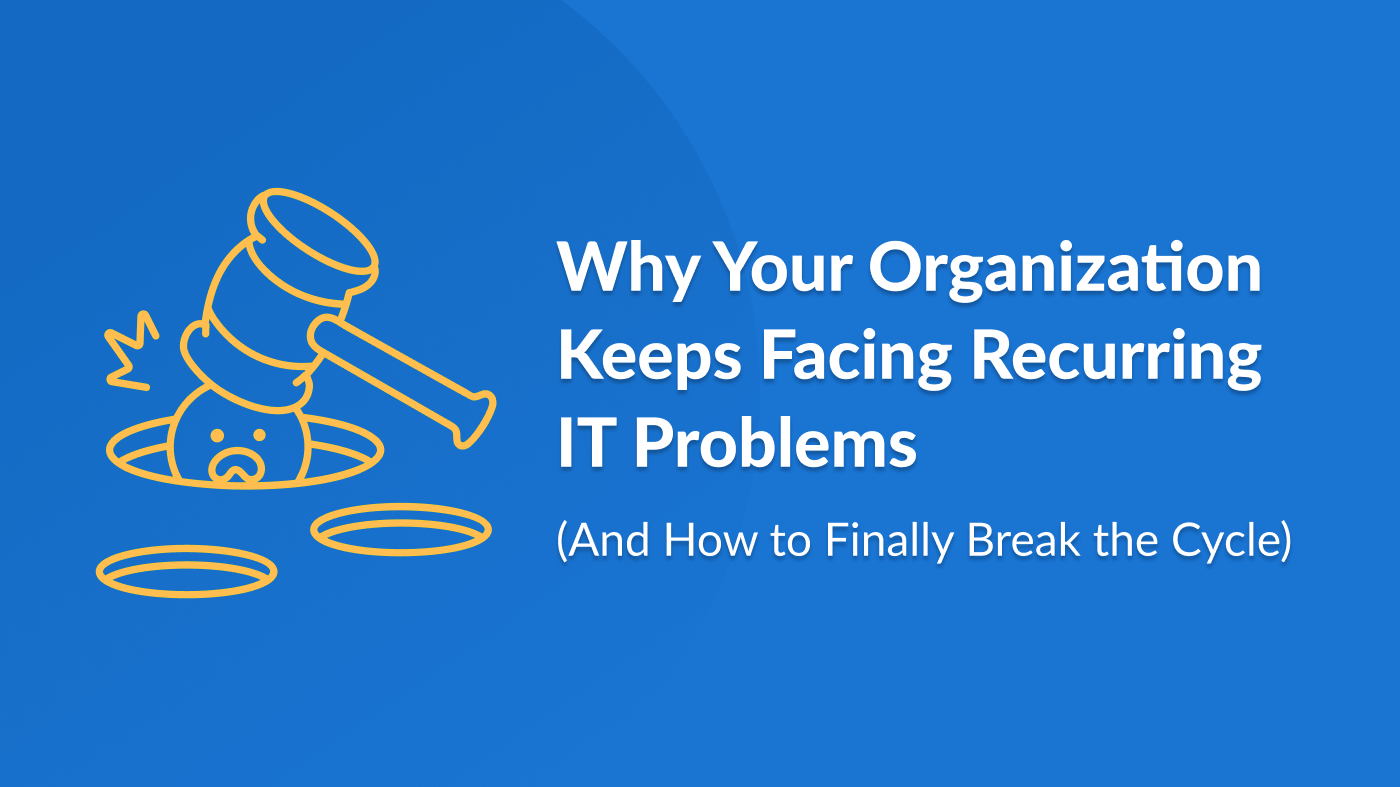Are you tired of dealing with the same IT problems over and over again? You fix one issue, only for it to pop up again like some kind of digital whack-a-mole. If this sounds familiar, you’re not alone. Plenty of businesses find themselves stuck in an endless cycle of recurring IT problems.
But here’s the thing: those surface-level issues are only symptoms of something deeper. And until you address the root causes, you’re just going to keep patching things up, not solving anything.
So let’s get real about what’s going on here. Here are seven reasons you’re caught in this loop, along with the bigger picture of why these problems persist—and what you can do about it.
1. Lack of Documentation Leads to Recurring IT Problems
When your IT provider doesn’t document solutions, every incident feels like the first time. Without a record of past fixes, the support team ends up winging it with temporary solutions that don’t last. And when they’re in a hurry, they’re not documenting how they solved it this time either. See the problem? You’re on a merry-go-round of recurring issues.
2. High Turnover of IT Staff
Turnover is brutal in IT. It’s a high-stress, reactive environment, so burnout is rampant. With a revolving door of IT staff, new hires rarely get up to speed on the nuances of your systems before they’re replaced. Each fresh face starts from scratch, dragging you back to square one. Sound familiar?
3. The Fire-Fighting Approach
When IT providers are too busy putting out fires, they don’t have time to solve the root cause of the problems. They might patch things up for now, but the underlying issue remains, ready to flare up again. That’s the curse of the “break-fix” model. If all they’re doing is fighting fires, they’re not planning for fire prevention.
4. Lack of Proactive Planning
Here’s the reality: preventing IT problems before they happen takes planning—and a lot of it. But if your provider is buried in daily support tickets, they’re not going to have the bandwidth to propose real, long-term solutions. No plan, no progress. Just more of the same issues showing up time and again.
5. Outdated or Incompatible Technology
You know what they say about tech: it ages like milk. If your systems aren’t staying compatible with current software and hardware standards, problems are inevitable. The longer you rely on legacy tech, the more you’ll deal with breakdowns and incompatibility, leaving your IT team in a constant scramble to keep things running.
6. Poor Training and Knowledge Transfer
Effective IT support isn’t just about having smart people on board—it’s about making sure they know your setup inside and out. Many IT providers lack structured training and knowledge transfer programs, so when new staff members come on, they don’t have a clear understanding of your environment. What does that mean for you? Recurring IT problems, because no one’s solving the issue completely.
7. Prioritizing Cost Over Quality
The IT support industry is focused on being cheap, not deep. The pricing model encourages providers to do just enough to keep things moving, addressing the surface-level problems without digging deeper. But deeper issues require time and expertise—and in a low-cost, high-volume environment, that’s the first thing to go.
The Real Reason Behind Recurring IT Problems
Let’s pull back the curtain on these problems, because what we’re seeing here are only symptoms. The root causes go deeper than just documentation or training gaps. If any of these scenarios sound familiar, you’re likely dealing with underlying issues that are much harder to see. Here’s what’s really going on:
-
Scalability Challenges: Most IT providers simply aren’t set up to scale with their clients’ needs. Small providers with fewer than 25 employees dominate the market, and they’re spread thin. They don’t have the structure to handle complex issues or grow alongside you—so they’re stuck offering the same basic services, while your needs keep expanding.
-
A Hyper-Competitive Labor Market: Here’s a stat that says it all—there are 8 open tech positions for every qualified candidate. That’s an insane supply-and-demand imbalance, which means high turnover, understaffed teams, and a talent crunch that makes it tough for providers to hire and retain the people they need. It’s no wonder they struggle to deliver consistent support.
-
An Immature Process: Many IT providers run on what our CEO calls the “alpha tech” model—one senior technician making most of the calls. It works in a small environment, but it’s unsustainable for larger or growing organizations. Without structured processes and a focus on documentation, these providers can’t solve your recurring problems—they’re barely keeping up themselves.
-
Market Focus on Low-Cost Services: Most IT providers charge less than $150 per user per month. Sounds great on the surface, but here’s the problem: low cost often means low quality. Providers working on tight margins have to cut corners to make things work, which means they can’t take the time to tackle root causes. Instead, they’re forced to focus on quick fixes, leaving bigger problems unsolved.
-
A Lack of Cybersecurity Preparedness: Many providers don’t have the resources to stay ahead of modern cybersecurity threats, which is critical to keeping your systems safe. Instead, they’re reactive—patching issues when they arise instead of implementing comprehensive cybersecurity hygiene. This leaves your organization vulnerable and your IT support team perpetually in crisis mode.
-
Operational Immaturity: IT providers need a solid foundation to handle complex client needs. But most are underfunded, understaffed, and struggling to keep up. With undefined roles and inadequate resources, it’s impossible for them to establish effective, long-term IT management. And that means you’re left dealing with recurring issues instead of proactive solutions.
You’re Not Alone (and Switching Providers Isn’t the Only Answer)
These deeper issues are incredibly common. If your organization is stuck in a loop of recurring IT problems, you’re not alone—and there’s nothing wrong with wanting to stick with your current provider. Switching providers can be disruptive and time-consuming, and if your IT team knows your setup, it makes sense to try and work through these challenges together.
That’s why we created a guide just for business leaders in your situation: "Learn 5 Vital Steps to Upgrade, Mend, or Transform Your IT Service Partnerships." This guide is designed to give you practical, no-nonsense steps you can take to fix the relationship with your current provider, address root causes, and break the cycle of recurring IT problems.
And we’re offering it for free. No email required, no strings attached.
Download the Free Guide Now
Ready to stop patching things up and start solving the real issues? Download "Learn 5 Vital Steps to Upgrade, Mend, or Transform Your IT Service Partnerships" and take control of your IT support. It’s time to build a path to dependable, strategic IT services that support your business instead of holding it back.
Download the eBook now
The truth is, IT support doesn’t have to be a source of constant frustration. With the right strategy, you can break the cycle, tackle the root causes, and build an IT environment that helps your business thrive. So let’s get started.



/jclause.jpg)
